Utah’s National Parks – where the ground rises before you to majestic peaks of multiple colours; where it bottoms out to vast valleys and canyons below your feet; where it turns watering holes into rapid rivers around the next corner; where the 4am wake-up calls to witness the birth of a new day is worth every second – and all this can be found in just one park.
Canyonlands, Arches, Capitol Reef, Zion and Bryce Canyon. These are the Mighty 5 National Parks of Utah.

According to Brand USA, Australian’s are flocking to these national treasures in record numbers and with this much natural beauty and diversity on offer it’s easy to see why. This is where being startled is a welcomed emotion.
[youtube https://www.youtube.com/watch?v=QlKOcyf915M]
Canyonlands National Park
The hardest part of being in the Canyonlands is deciding how you will see it. Bike it, climb it, raft it, hike it, 4WD it or take in it’s scenery from the air. A popular area for four wheel driving and mountain biking with several trails laid out for the public including the 100 mile White Rim Trail. Canyonlands can easily accommodate all levels of sightseeing and physical activity.
Canyonlands Weather
Summer can exceed 100F (38C) and any trip will require some careful planning. Food and water should be carried at all times and activities are best enjoyed in early morning or evening. Winter temperatures can drop to freezing overnight and spring and autumn can provide comfortable temperatures but will include thunderstorms bringing the risk of flash flooding periodically.
Accommodation
Canyonlands offer two camp grounds located at Island in the Sky and the Needles Districts. Camping is on a first come, first serve basis and permits can be reserved for back-country camping. Other parts of the park offer lodging from RV (Motorhome) parks, cabins and lodges to upscale hotels or multi-person units.
Area Size
At 337,598 acres, or 527 square miles (1,365 square kilometers), Canyonlands is Utah’s largest designated national park.
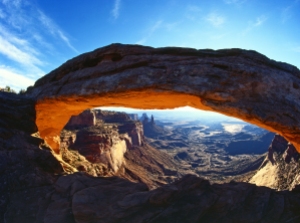
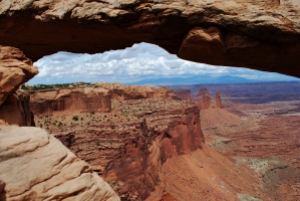
Arches National Park
Arches National Park is known as the ‘land of sculptures’ providing dramatic landscapes and back drops. Home to over 2,000 natural arches, one could think this was once the playground of mythical giants. Fields of spires, domes and gravity defying, well balanced formations will give any hiker a rewarding journey. Climbing, hiking, road bikes, 4WD and camping are all on offer. Some of the best views can be seen during sunrise or sunset where the lighting is at its best.
Arches Weather
Similar to the Canyonlands with summer temperatures exceeding 100F (38C), trips require careful planning. Food and extra water plus sunscreen and appropriate footwear should be considered and activities are best enjoyed in early morning or evening to beat the heat. Winter temperatures can drop to freezing overnight and spring and autumn can provide comfortable temperatures but will include thunderstorms bringing the risk of flash flooding periodically.
Accommodation
Arches National Park offer developed camp grounds throughout the park. Camping is on a first come, first serve basis but reservations can be made during popular summer months. Permits for back-country camping can be obtained for free in advance. Other parts of the park offer lodging from RV (Motorhome) parks, cabins and lodges to upscale hotels or multi-person units.
Area Size
Arches National Park covers 76,359 acres (119 square miles or 308 square kilometers) with good paved and unpaved road access to much of the park.
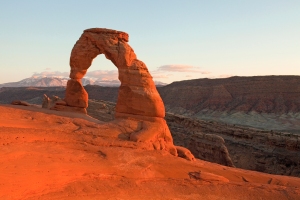
Read more on Utah – Scare Canyon, Wild Elk, a Rustic Log Cabin & an Australian Tourist
More National Parks – Guide to America’s National Parks
Grand Canyon – The south rim Grand Canyon review in pictures
Bryce Canyon National Park
Views from 9,000 feet (2,743 metres) will have your camera running on overload, especially at sunrise or sunset where the hues of changing colour draw crowds from far. Overlooking natural amphitheaters and distinctive red rock pillars of stone carved into pink cliffs of the Paunsaugunt Plateau make it hard to not stop and stare. Bryce Canyon can be enjoyed by foot, car, horseback or mountain bike along the many visitor trails. Fishing is available (license required) at the nearby Panguitch Lake. Off-road trails in the adjacent Dixie National Forest offer unique views back into Bryce Canyon.
Bryce Canyon Weather
With a combined mountain and dessert climate, unique weather patterns can be found within Bryce Canyon National Park. Sunscreen, hats and extra water are required for summer months where afternoon storms can be common making for dramatic lighting and scenery. While not as warm as other parks, summer months range between 70-80F (25C) while winter can be a frigid yet beautiful 46F (8C) with the cooldest month of January averaging 36F (2C). Night time dips below freezing.
Accommodation
Bryce Canyon is one of the most popular National Parks so reserve your campsite well in advance. Accomoodation options range from luxury to budget in the area with Ruby’s Inn the closest lodge to the canyon rim offering private access to the park. Camping is also available in the surrounding Dixie National Forest or Grand Staircase-Escalante National Monument. Other options are available in gateway towns along Scenic Byway 12, from Panguitch to Torrey. For a unique experience, pull on cowboy boots and saddle up at a working Old West Dude Ranch in Antimony to complete your outdoor adventure at Bryce Canyon.
Area Size
35,835 acres (56.2 square miles, 145 square kilometers). Stay on the road, try various short hikes or disappear for a couple of days into Bryce Canyon’s back-country.
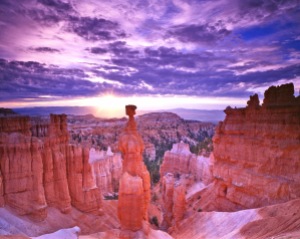
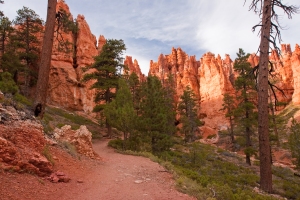
Capitol Reef National Park
Capitol Reef is home to the Waterpocket Fold which spans over 100 miles (160km). Birthed millions of years ago, this wrinkle in the earths crust was created during the formation of the Rocky Mountains. Earning it’s name from the bulging uplift of rainbow-hued sandstone ‘reefs’ and canyons. Activities include hiking, backpacking, fishing (with a license) and bike riding. Within a few hours you can be hiking desert trails in wide-open canyons to picking fresh in-season fruit from the Scenic Byways orchids.
Capitol Reef Weather
Similar to Bryce Canyon, Capitol Reef combines mountain and dessert climate that produce unique weather patterns. Summer months require sunscreen, hats and extra water. Afternoon storms can be common which can add flash flooding periodically. Summer months range between 70-80F (25C) while winter temps average 46F (8C) with the coldest month being January. Evening temperatures dip below freezing.
Accommodation
Capitol Reef campgrounds are first come, first serve. A developed campground can be found in the town of Fruita. The back-country have rugged camp grounds available. Gateway towns between Hanksville and Loa offer various motel and bed and breakfast accommodations, including a Ranch Bed and Breakfast in Notom.
Area Size
Capitol Reef’s 378 square miles (979 square kilometers) unfold over the 100-mile-long park (160 kilometers) through the center part of Southern Utah.
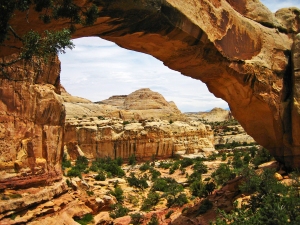
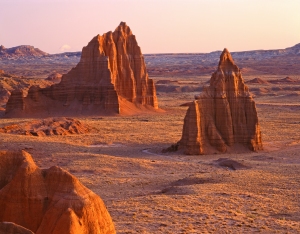
Zion National Park
Zion translates to ‘the promised land’ and lives up to its expectations. Walk through towering cliffs with large waterfalls, stroll by deep rivers with hanging wildflower gardens or discover Zion Narrows where you can reach your arms out and touch both walls as you walk. An easy and accessible National Park with several tourist shuttles and hiking paths that are both wheelchair and stroller friendly. Guided horse-back riding is available with hiking, biking plus permitted watercraft and kyack activities when the waters are high enough. A spectacular destination for the whole family or adventures alike.
Zion National Park Weather
Open year round, Zion’s summer temperature can average 95F (35C) but generally dry with the occasional rain storms sweeping through the area. Evening temperatures can drop dramatically and unexpectedly by 30F (18C) so being clothing prepared if staying late is recommended. Cooler temperatures during spring and autumn and winter months can be cold and wet.
Accommodation
Being a popular destination year round, camp grounds fill up fast. The Watchmen Campground can be reserved or there is a first come, first serve option at South Campground. The most popular choice is the historic Zion National Park Lodge which is on the doorstep of many hiking trails. Gateway towns of La Verkin, Virgin, Rockville and Springdale provide accommodation options from campgrounds and RV (motorhome) parks to brand-name motels and upscale hotels.
Area Size
You can get to know your fellow campers or escape into Zion National Park’s 232 square miles (593 square kilometers). That’s 148,733 acres, over 124,000 of which are designated as Zion Wilderness Area.
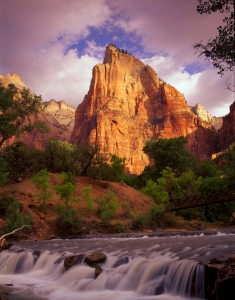

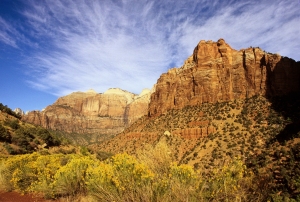





Comments
Comments are closed.